
Circular and square earthen buildings huddle together, blending in with their natural surroundings. [PHOTO BY SHEN ZHIJIAN/FOR CHINA DAILY]
Traditional ethnic-style construction fascinates tourists as they get to experience its unique appearance and functionality, Yang Feiyue reports.
Amid idyllic surroundings featuring cobblestone paths, deep ruts left by ox carts, lush farmland and a clear gushing river, a group of historical buildings stand out like jewels in the crown at Yunshuiyao ancient town.
Known as tulou, or earthen buildings, those circular and rectangular buildings are mostly set among rice, tea and tobacco fields and some can house up to 800 people.
Built around a central open courtyard with only one entrance and windows to the outside only above the first floor, these earthen buildings feature faded yellow clay walls and dark-brown timber roofs that look out of this world, yet have a strange way of blending in with their surroundings. They provide visitors with breathtaking views and a sense of peace and quiet.
"We've seen an increasing number of visitors, most of whom have had their curiosity piqued by tulou," says Zhang Mintai, who grew up in a local tulou neighborhood and has witnessed the rising popularity of the town in Nanjing county, Zhangzhou city of Southeast China's Fujian province.

A group of historical buildings next to cobblestone paths, lush farmland and a clear river, make for an idyllic picture at Yunshuiyao ancient town in Nanjing county, Fujian province. [PHOTO BY YANG YI/FOR CHINA DAILY]
Scattered across the province's mountainous regions, tulou first emerged in the 12th century.
They were built by the Hakka, whose name literally means "guest people".Those early builders were mostly migrants who originated from lands adjoining the Yellow River and moved to southern China. Population pressure gave rise to conflict between the Hakka and their neighbors, so they built their homes to double as fortifications.
Built amid steep terrain, and with a relatively sparse population, tulou enabled their residents to live together, protected from wild animals and rampaging bandits.
To date, there are more than 150,000 tulou buildings in Nanjing county, and more than 23,000 in the Yongding district of Longyan city, located about 50 minutes away by car.

A bird's eye view of the earthen buildings in Nanjing county, Fujian province, surrounded by forests and tiered farmlands. [PHOTO BY HUANG QIUHUA/FOR CHINA DAILY]
Those buildings became better known after 46 of them were given World Heritage status by UNESCO in 2008.
UNESCO says on its website that "they are exceptional examples of a building of tradition and function, exemplifying a particular type of communal living and defensive organization, and, in terms of their harmonious relationship with their environment, an outstanding example of human settlement".
Zhang says that "a major charm of tulou lies in them being made of rammed earth and wood, yet being able to stand the test of time, lasting for more than 1,000 years".
Now in his 70s, he witnessed the whole construction process of tulou during his childhood, before becoming engaged in building them himself in his teens.
"In the construction of those earthen buildings, one must master four actions of striking, pounding, hitting, and patting," Zhang explains.
The county stopped construction of new tulou after the 1970s, preserving only the 20 that have the UNESCO status, but Zhang is still attached to the ancient buildings.
"The cohabitation of dozens of households and several hundred people in one earthen building reflects the Hakka tradition of living together as a clan and harmoniously coexisting as a family," he says.
"In addition, the use of local materials to construct a tall and grand earthen fortress, turning the ordinary into the extraordinary, showcases the ingenuity of the Hakka in the process of conquering nature," he adds.
Zhang says it is this cultural significance that inspired him to persist in practicing the ancient art of rammed earth construction for several decades.
He eventually found an outlet to continue his enthusiasm when, in 2017, local authorities opened a facility providing the opportunity for tourists to experience the lifestyle that these buildings offer at the Nanjing tulou scenic spot.
He would stand before a miniature mold at the facility and explain the craft behind the ancient architectural techniques to visitors, while introducing the history and culture behind them.
Whenever he has time, Zhang also takes the initiative to chat with visitors across the whole tulou scenic spot to help them better appreciate its charm.
The soil used often came from below the fertile layer of the paddy fields because it can be hardened by calcification, Zhang says.
"It was essential to choose cohesive soil mixed with sand," Zhang says, adding that egg white, brown sugar, glutinous rice and lime were added to the soil in some places.

Heguilou is tucked away in a sea of lotus flowers in Nanjing county, Fujian province. [PHOTO BY CHEN HAIYAN/FOR CHINA DAILY]
Pieces of pinewood were also mixed into the raw materials to make them more solid.
Jian Rongwei, former curator of the Nanjing county museum, has been studying the construction techniques of Hakka earthen buildings for years, and believes the essence of the craftsmanship lies in "the extreme height-to-thickness ratio achieved in their walls".
The ratio found in over 1,300 large tulou in Nanjing generally reaches 10 to 1, as opposed to 3 to 1 in other traditional rammed earth constructions.
"The thickness of the wall base has been reduced by a full 3 meters (than conventional buildings), gradually decreasing as it rises while slightly sloping inward to form a trapezoidal shape with a strong inward force," Jian explains.
"It results in excellent seismic resistance," he adds.
Moreover, the ancient wisdom of the Hakka managed to overcome challenges, ranging from hardening the loose raw earth, to keeping it resistant against rainwater.
"It takes far more work than just compacting the soil with the ramming tools, which were made of a few wooden boards and sticks," Jian says.
"In fact, it involves careful consideration of such aspects as selecting and proportioning raw soil, human labor input, the addition of pinewood, ramming techniques, weather conditions, and the construction period," he explains.

Huaiyuanlou at sunset. [PHOTO BY ZHANG JIE/FOR CHINA DAILY]
Take the Huaiyuanlou in the county as an example. The four-story, 14.5-meter-high tulou on the UNESCO list had dozens of people spend more than 4 years mixing soil, setting up tools, doing measurements, ramming the earth, laying pinewood, and patting the walls.
"Everyone had clear responsibilities, and each step was well-organized. To ensure the solidification and drying of the walls, they would pause construction for a year after completing each layer of ramming," Jian says.
He emphasizes that the enduring strength, and no signs of peeling, in the walls of the Huaiyuanlou are attributed to the meticulous execution of each step during the construction.
"Hundreds of pinewood pieces were used and a large pit was dug nearby to source the raw soil."
The significance of the earthen structures has also motivated locals to tap into the rich tulou resources and repurpose some that were in a poor condition.
At Tianzhong village in Nanjing, a total of seven tulou underwent restorative construction by experienced craftsmen starting in 2014.
"We did our best to preserve the historical styles and features of those tulou," says Ye Fan, chair of the company in charge of the renovation.
The idea was to "excavate the profound historical and folk culture, and retain the soul and foundation of the earthen buildings," Ye says.
The move has helped the village pack in more than 300,000 traveler visits and enabled local households to leverage opportunities in the homestay and catering sectors.
Many local young people have come back to start up their own business.
Huang Zhihui was one of the first to quit his big-city job and return home after tulou began to receive widespread attention in 2008.
He runs a website that offers tourists curated routes, reception, transportation and accommodation in Nanjing.
He has also led his team to develop the highest homestay in not only tulou scenic spot, but the county.
"With the development of tourism, people's expectations for living conditions have become increasingly high," Huang says.
The homestay is in the fashion of a square tulou with campus elements, and, as well as learning ramming techniques, farming and fruit picking experiences are available for visitors.
"I hope that through the hospitality provided by the homestay and interactions with the tourists, they can truly experience the friendliness of the local people. I want to give them more opportunities to understand and immerse themselves in the rich local culture and customs associated with the earthen buildings," Huang says.
He has created songs about tulou to popularize their charm and he often gets together with friends in the homestay business to discuss development of the industry.
For Zhang, the positive changes happening in his hometown over the years have charged him with excitement and forged a sense of responsibility.
He says he is excited about tulou being recognized by the world and the Hakka construction craft being named a national intangible cultural heritage in 2011.
"As an inheritor, I feel more motivated to take a lead in recording, inheriting and displaying this ancient craft," he says.














